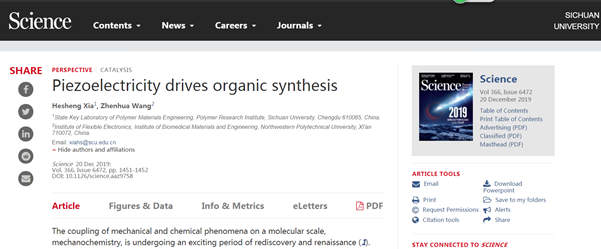On December 20th ,Sciencepublished a perspective entitled “Piezoelectricity Drives Organic Synthesis: Ball Milling Allows for Solvent-Free Mechanoredox Catalysis” ( Science, 2019, 366, 1451-1452 ). The authors are Hesheng Xia, professor of SCUState Key Laboratory of Polymer Materials Engineering and Dr. Zhenhua Wang of Institute of Flexible Electronics, Northwestern Polytechnical University. Professor Hesheng Xia is the first author and Sichuan University is the first work unit. In light of the new progress in mechanochemistry in recent years, the perspective reviews the research work of "Redox Reactions of Small Organic Molecules Using Ball Milling and Piezoelectric Materials ( Science,2019, 366, 1500-1504 )" published by Kubota et al and expresses outlooks for the future research.

According to the perspective, mechanochemistry is undergoing a period of rediscovering and renaissance. “(1). Mechanochemistry research can provide deep insight into the rupture mechanism of chemical bonds (2). Mechanochemical routes for chemical synthesis can minimize the use of hazardous or undesirable solvents. They also can generate materials along reaction pathways that are inaccessible through thermal or light-activated processes. On page 1500 of this issue, Kubota et al. demonstrate that piezoelectric materials can be used as mechanoredox catalysts for organic synthesis (3).” ( Summary)
In this paper, the authors has also prospected mechanoredox catalysis. Mechanochemistry is widely used in many fields, including nano particle preparation, organic and polymer synthesis, polymer processing, plastic or rubber recovery, electrochemical energy storage, water treatment, drug eutectic synthesis, metal organic complex, graphene stripping, carbon nanotube cutting, dynamic covalent chemical bond performance regulation, self repair and so on. Force catalytic oxidation-reduction has opened up a new way of mechanochemistry for many kinds of organic oxidation-reduction reactions, which can be extended to the chemical fields related to free radicals, such as polymerization, grafting and crosslinking reactions, degradation and recovery, etc.
